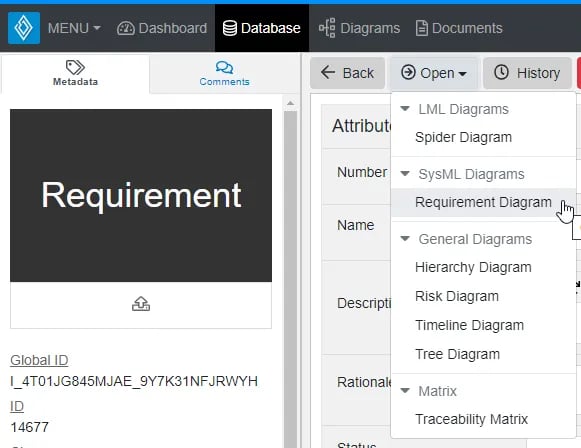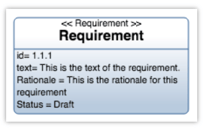Requirements Diagram
Display requirements, their hierarchy, relationships and more in Innoslate's Requirement Diagram.
Using Requirement Diagrams
| Function | Description |
|---|---|
| Creating Requirement Diagrams | Using ‘Diagrams Dashboard’ in Innoslate, you can create a new ‘Requirement Diagram.’ |
| Viewing Requirement Diagrams | You can ‘View a Requirement Diagram’ of any new or existing entity of any class via the ‘Open’ drop-down menu, where available. |
| Requirement Diagram Constructs | The ‘Requirement Diagram’ supports two unique diagram constructs: a ‘Requirement’ and an ‘Entity.’ |
| Adding a Requirement | A ‘Requirement’ construct can be added to a ‘Requirement Diagram’ via drag-and-drop. |
| Adding an Entity | An ‘Entity’ construct can be added to a ‘Requirement Diagram’ via drag-and-drop. |
| Removing a Construct | A construct can be easily removed from a ‘Requirement Diagram.’ |
The ‘Requirement Diagram’ displays requirements, their hierarchy, and their relationships to model entities.

Creating Requirement Diagrams
Within the ‘Diagrams Dashboard,’ users can create a new diagram by clicking the ‘ Create Diagram’ button in the top right corner of the page.

Clicking the ‘ Create Diagram’ button will open the New Diagram dialog where you will be directed through the process of creating a new diagram.
Create a Requirement Diagram
- Choose Which Type of Diagram to Create
In step 1, select ‘Requirement Diagram,’ under ‘SysML,’ as your diagram type.

Click the ‘Next’ button.

- Specify New Root Action Information
In step 2, you will be prompted to input a diagram ‘Name,’ ‘Number’ (optional), and ‘Description’ (optional). Then, click the ‘Finish’ button to save and automatically open your new Requirement Diagram.

Viewing Requirement Diagrams
In Innoslate, you can view a ‘Requirement Diagram’ from wherever the ‘Open’ drop-down menu is available on the toolbar (Entity View, Database View, within a Document, within a Diagram, within a Test Suite).
View a Requirement Diagram
- Locate and click the ‘Open’ drop-down menu in the toolbar. Select ‘Requirement Diagram.’

- This will navigate you to view a ‘Requirement Diagram,’ where you can begin adding and removing entities. Click the ‘Save’ button located on the toolbar to persist your changes to your project’s database.
Requirement Diagram Constructs
The ‘Requirement Diagram’ supports two unique diagram constructs: a ‘Requirement’ and an ‘Entity.’
-
Requirement
This construct is used to represent a physical or functional capability necessary for the system being modeled.
In the system model, a Requirement entity is used to represent a ‘Requirement’ construct. Innoslate’s default database schema includes labels to specify the type of this Requirement entity as a(n) Environmental Requirement, Functional Requirement, Interface Requirement, Performance Requirement, Reliability Requirement, Safety Requirement, and/or Verification Requirement.
In the diagram, this construct is represented as a rounded block with two sections. The top section which contains the name of the ‘Requirement’ and the bottom section contains the identifier, text, and rationale of the ‘Requirement.’

-
Entity
In the system model, an entity of any schema-based class can be used in the ‘Requirement Diagram.’ The purpose of this ability is to derive relationships between the entity and the ‘Requirement’ constructs. In the diagram, this construct is represented as a rounded block that contains the name of the entity.

Adding a Requirement
Additional ‘Requirement’ constructs can be added to a ‘Requirement Diagram‘ via drag-and-drop.
-
Within a ‘Requirement Diagram,’ click the ‘Requirement’ icon in the ‘New’ tab of the left sidebar and continue to hold down the left mouse button.

-
Drag the ‘Requirement’ icon over to the adjacent diagram canvas.

-
Release the left mouse button while over the diagram canvas to drop the new ‘Requirement’ and add it to the diagram.

Notice the ‘Requirement’ stays selected once it has been dropped. Since it is selected, the toolbar changes to include buttons for functions that can be used on the construct. The sidebar also changes to include additional ‘Metadata,’ ‘Attributes,’ and ‘Relationships’ tabs.
-
Once added to the diagram, enter a meaningful ‘Name’ for your new ‘Requirement’ via the ‘Attributes’ tab of the left sidebar (focused automatically for convenience).

-
Click the ‘Save’ button located on the toolbar to persist your changes to your project’s database.

* Note: The above process describes using the ‘New’ tab of the left sidebar, which automatically generates a new entity to represent each new diagram construct. If you would like to reuse existing entities from your database to represent a new construct, use the ‘Existing’ tab instead.
Adding an Entity
An entity can be added to a ‘Requirement Diagram’ via drag-and-drop.
- Within a ‘Requirement Diagram,’ select from the drop-down which schema-based class of entities you would like to add to the diagram. Search or scroll within the drop-down to find your desired class if need be.

* Note: By default, the schema-based class Requirement is selected; however, the overall process is the same regardless of the selected class. Going forward, this example will use the Action class.
- Click the Action entity icon in the ‘New’ tab of the left sidebar and continue to hold down the left mouse button.

- Drag the Action entity icon over to the adjacent diagram canvas.

- Release the left mouse button while over the diagram canvas to drop the new Action entity and add it to the diagram.

Notice the entity stays selected once it has been dropped. Since it is selected, the toolbar changes to include buttons for functions that can be used on the construct. The sidebar also changes to include additional ‘Metadata,’ ‘Attributes,’ and ‘Relationships’ tabs.
- Once added to the diagram, enter a meaningful ‘Name’ for your new Action entity via the ‘Attributes’ tab of the left sidebar (focused automatically for convenience).

- Click the ‘Save’ button located on the toolbar to persist your changes to your project’s database.

* Note: The above process describes using the ‘New’ tab of the left sidebar, which automatically generates a new entity to represent each new diagram construct. If you would like to reuse existing entities from your database to represent a new construct, use the ‘Existing’ tab instead.
Removing a Construct
A construct can be easily removed from a ‘Requirement Diagram.’
- Within a ‘Requirement Diagram,’ select the construct you wish to remove. This will make the toolbar appear with applicable functions which can be used on the selected construct.

- Click the ‘Remove’ button to remove the construct from the diagram (as the default action).

* Note: The ‘Remove’ button also includes a drop-down menu where you can select ‘Delete from Database’ or the default option of ‘Remove from Diagram.’
Tutorial Video
To continue learning about SysML Diagrams, Click Here.
(Next Article: Requirements Diagram Modifications & Settings)
